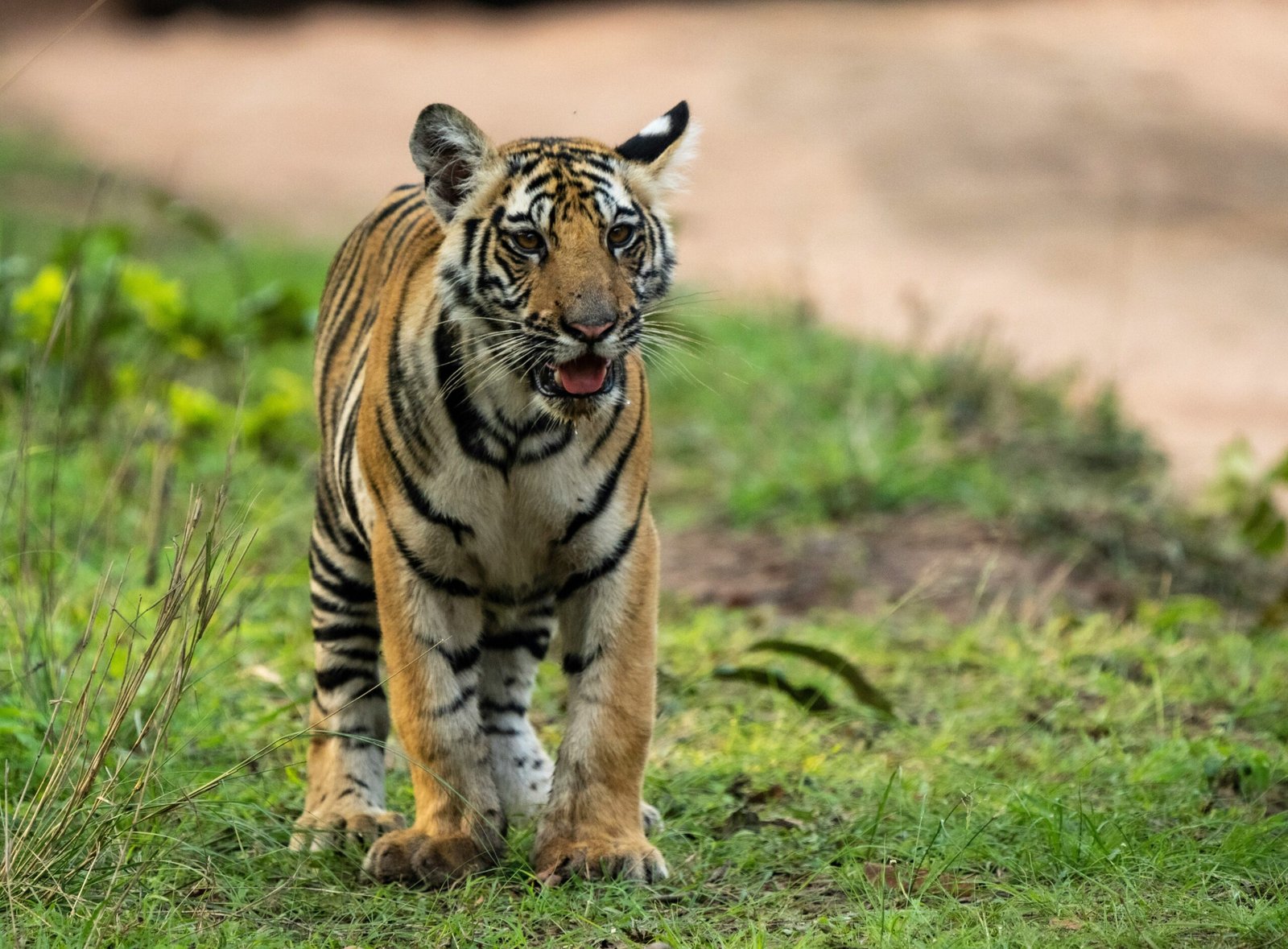Introduction to Tiger Cubs
The world of tiger cubs is both enchanting and educational, offering a glimpse into the early stages of development of one of nature’s most majestic predators. When tiger cubs are born, they are typically blind and helpless, relying entirely on their mothers for care and survival. Over the first few weeks of life, their senses begin to develop, and they start to explore their surroundings. This period of growth is crucial, as it lays the groundwork for their future as adept hunters and social animals.
From a young age, tiger cubs exhibit a playful nature that is not only adorable but also essential for their learning processes. Engaging in mock fights and playful antics with their siblings, they hone vital skills such as coordination, strength, and agility. These interactions are fundamental in teaching them the nuances of social behavior and establishing bonds, not only with their littermates but also with their mother. Through play, tiger cubs learn important survival skills that they will utilize in adulthood, enhancing their ability to hunt and interact with other tigers.
Moreover, the significance of play extends beyond mere enjoyment; it serves as an intrinsic part of their development. Through playful encounters, tiger cubs reinforce their physical capacities and social flexibility, shaping their character and instincts as they transition into adulthood. While they may appear cute and cuddly, their playful nature is an integral component in preparing them for the challenges they will face as mature tigers in the wild. Understanding the early lives of tiger cubs enriches our appreciation for these magnificent creatures and highlights the importance of protecting their habitats to ensure their continued survival.
The Importance of Play in Animal Development
Playtime activities, especially those involving wrestling, are essential to the development of young animals, including tiger cubs. Engaging in these playful interactions allows them to refine their physical skills, which are crucial for their survival in the wild. During wrestling sessions, cubs practice various motor skills such as jumping, climbing, and maneuvering their bodies. This type of physical engagement is a fundamental component of their growth, equipping them with the agility and strength necessary for hunting and avoiding predators later in life.
Moreover, wrestling among tiger cubs is not solely about physical development; it also serves a critical social function. Through these playful encounters, cubs establish and strengthen their social bonds with littermates. The interactions that occur during play foster cooperation and communication, vital skills that will serve them later as they navigate the complexities of social structures in their environments. These relationships aid in their overall emotional and psychological development, promoting a sense of security within their familial units.
Additionally, play is an opportunity for young animals to learn important survival strategies and behaviors that they will rely on throughout their lives. As they wrestle, they experiment with different techniques and reactions, effectively simulating real-life encounters. This form of learning through play is significantly advantageous; it enables them to understand their capabilities and limitations in a safe context. Such experiences contribute to the creation of instinctual patterns that are critical when they eventually compete for resources or defend themselves against threats.
In essence, the role of play—particularly wrestling—in the lives of tiger cubs cannot be overstated. It plays a pivotal part in their physical, social, and cognitive development, facilitating a well-rounded foundation for their future survival. Understanding the dynamics of play can provide deeper insights into the lives of these magnificent creatures as they grow and thrive in their natural habitats.
The Adorable Clip: Setting the Scene
In the captivating footage, viewers are introduced to a vibrant setting where a group of playful tiger cubs engage in delightful wrestling matches. The scene unfolds in a lush, natural habitat, characterized by a sun-dappled clearing surrounded by vibrant greenery and gentle sounds of wildlife. This backdrop not only enhances the visual appeal but also reflects the fantastical world these young cubs inhabit, completely at ease in their playful antics.
There are four tiger cubs featured in the clip, each demonstrating a unique personality that adds to the charm of the moment. Their soft, golden fur contrasts beautifully with the lush green grass beneath them, while the dappled sunlight creates a warm, inviting atmosphere. As the cubs tumble and roll over one another, they emit a sequence of playful growls and chirps, encapsulating the essence of youthful exuberance. The energy is contagious, evoking laughter and admiration from anyone fortunate enough to witness their antics.
As the focus shifts from one cub to another, viewers can spot the intricate details in their behavior. One cub boldly pounces onto another, showcasing its agility, while another cub innocently flops over as it attempts a playful maneuver. The innocent curiosity and raw energy of these young tigers immerse the audience in a heartwarming experience, highlighting their bond as siblings while they engage in this delightful form of play.
These tiger cubs embody the wonder of childhood and the essential skills being developed through their playful wrestling. This adorable visual encapsulates the essence of wildlife, illustrating the sheer joy found in nature’s youthful creatures. Viewers are left with a sense of warmth and happiness, eagerly anticipating the delightful journey of these playful tiger cubs.
Analyzing the Wrestling Techniques of Tiger Cubs
The wrestling techniques displayed by tiger cubs illustrate a fascinating mix of playfulness and instinctual learning. In various videos showcasing these adorable young felines, one can observe a range of strategies that mimic the behaviors they will adopt as adults. Notably, pouncing is a prevalent tactic. Tiger cubs exhibit remarkable agility and timing, often launching themselves at siblings in an effort to engage them in playful combat. This behavior not only strengthens their physical condition but also fosters vital social bonds among littermates.
Another prominent technique utilized by these young tigers is rolling. When engaged in wrestling matches, tiger cubs frequently tumble over one another, showcasing their strength and coordination. This rolling maneuver is not merely for entertainment; it serves a significant purpose in their development. By learning to control their body movements, cubs enhance their spatial awareness, which is essential for hunting. Adult tigers utilize similar rolling techniques when grappling with prey, thus imbuing the cubs’ playful antics with a deeper meaning related to their survival skills.
Playful biting is another characteristic move in these wrestling encounters. Although it may appear innocuous, this behavior is a critical aspect of their growth. The cubs softly nip or bite their siblings, providing an avenue for practicing their predatory skills without the risk of injury. This form of bite pressure helps to refine their hunting abilities, as restraint is crucial in the wild. Through this playful biting, tiger cubs learn about the boundaries of strength and the importance of coordination in both social interactions and hunting scenarios.
In essence, the wrestling of tiger cubs is much more than mere play; it is a dynamic exercise that prepares them for the challenges of adulthood while also solidifying their familial bonds.
The Bonding Experience: Cubs and Their Siblings
The sibling dynamics observed during wrestling sessions among tiger cubs play a crucial role in shaping their social and psychological development. These playful interactions, often filled with vigorous wrestling and chasing, are not merely games; they are essential components of the cubs’ growth. Engaging in such playful behavior helps to establish hierarchy, encourages cooperation, and promotes important social skills that will be vital for their survival in the wild.
During these wrestling sessions, tiger cubs learn to navigate their relationships with one another. The sibling rivalry that naturally emerges invites competition and the honing of instinctual skills. Through various forms of play, the cubs practice essential behaviors such as pouncing, stalking, and defending themselves, all of which are integral to their development as future independent hunters. Moreover, these interactions foster connections among siblings, instilling a sense of security within the family unit.
The significance of these bonds cannot be understated. As tiger cubs wrestle, they develop trust and form attachments that may last throughout their lives. Strong sibling relationships enhance emotional well-being, allowing cubs to express themselves freely while also learning the importance of empathy and resilience. The playful nature of their interactions provides a safe outlet for the cubs to explore boundaries and understand their physical capabilities.
Furthermore, the nurturing environment created by these wrestling sessions helps to mitigate stress and anxiety that may arise from the challenges of life in the wild. The act of playful wrestling not only fosters connection but also allows tiger cubs to learn from one another, reinforcing their familial bonds. As they grow and continue to engage in these vital interactions, the bonding experience between siblings lays a strong foundation for their future social structures within their habitats.
The Role of Adults in Tiger Cub Play
Adult tigers play a crucial role in the development and socialization of their cubs, particularly during play. This stage is vital as the cubs learn essential skills that will aid them in adulthood, such as hunting, fighting, and social interaction. Although tigers are solitary creatures, adult females exhibit strong parental instincts, often dedicating a significant portion of their time to supervising and engaging with their young. By observing their behaviors, it becomes evident how essential this interaction is for the tiger cubs’ learning processes.
The presence of adult tigers provides a safety net for the cubs as they explore their environment. While play often appears to be a light-hearted activity, it is intricately tied to survival skills. Adult tigers tend to encourage this playful behavior, which typically involves mock wrestling and pouncing. Such activities are not merely for enjoyment; they are instrumental in teaching the cubs balance, coordination, and timing—skills necessary for capturing prey in their natural habitat.
Moreover, adult tigers also serve as models of behavior for their cubs. By observing their mothers, cubs learn about essential social interactions. The adult tigers display important skills, such as how to assert dominance, engage in social grooming, and establish bonds, which are critical for future interactions with other tigers. This mentorship helps cubs better understand the intricacies of their social structure.
Additionally, while adult tigers maintain their protective roles, they also need to allow the cubs space to make mistakes. Such experiences are pivotal, as they teach resilience and adaptability, important traits for survival in the wild. The balance struck by adult tigers in playing alongside, supporting, and guiding their cubs highlights the significance of parental involvement in the formative stages of a tiger’s life.
The Impact of Losing Playtime: Conservation Insights
The significance of play in the lives of tiger cubs cannot be overstated. While play may seem like a mere pastime, it serves a crucial role in the development of essential skills such as hunting, social interactions, and self-defense. Unfortunately, the loss of natural habitats due to human activities has severe implications for tiger populations. Deforestation, urbanization, and infrastructure development encroach upon the territories that these magnificent creatures need for their survival, significantly reducing their play spaces and opportunities for learning.
As tiger cubs are born, they rely on their mothers and the surrounding environment to provide stimulating experiences that encourage roughhousing, climbing, and exploring. These activities are essential for developing social bonds and mastering hunting techniques. When habitats are fragmented, the available space for these vital play activities diminishes, leading to limited opportunities for the cubs to hone their skills in a natural setting. This reduction in playtime can result in inadequate preparation for adulthood, ultimately affecting the survival rates and overall well-being of wild tigers.
Conservation efforts, therefore, are of utmost importance in restoring and protecting the natural environments that facilitate healthy development in tiger cubs. Organizations dedicated to wildlife preservation work tirelessly to create protected areas, enhance habitat connectivity, and educate local communities about the importance of maintaining these ecosystems. By safeguarding the territories where tigers can thrive, we ensure that the next generation of tiger cubs has the necessary space to engage in play and learn the skills they need to thrive and survive in the wild.
In conclusion, the interplay of play and habitat preservation is critical for the future of tiger populations. Ensuring these animals have ample space to explore and engage in essential behaviors not only contributes to their individual development but also to the continuation of their species as a whole.
Viewer Reactions: The Heartwarming Effect
The heartwarming journey of tiger cubs learning to wrestle has captivated audiences across various social media platforms. As videos of these playful and adorable moments circulate, viewers are quick to express their emotions, showcasing the profound impact such content has on public perception towards wildlife. Comments from social media users reveal a tapestry of joy, laughter, and admiration for these magnificent creatures as they engage in their endearing wrestling antics.
Many viewers describe their reactions as overwhelmingly positive, with comments emphasizing the contagious joy seen in the cubs’ interactions. One social media user remarked, “I couldn’t help but smile watching these little tigers play; it made my day brighter!” This sentiment echoes through countless remarks, revealing how the innocent frolicking of tiger cubs evokes nostalgia and a sense of childlike wonder among spectators. Viewers often find themselves reminiscing about their own childhood interactions with animals, which adds to the emotional resonance of the clips.
Moreover, the adorable wrestling sessions of these tiger cubs serve a dual purpose; they not only entertain but also educate audiences about the importance of wildlife conservation. Comments on these posts frequently touch on the necessity of protecting such species in their natural habitats. For instance, one viewer articulated, “Seeing these cubs reminds me of how vital it is to support conservation efforts; they deserve to thrive in the wild.” This connection between entertainment and awareness fosters a community of individuals who appreciate the beauty and fragility of wildlife.
In conclusion, the viewer reactions captured during the sharing of tiger cubs wrestling not only highlight the emotional responses elicited by these clips but also promote a greater appreciation for wildlife conservation. By engaging with such content, audiences can cultivate a deeper understanding of and connection to the natural world, underscoring the significance of preserving these magnificent creatures for future generations.
Conclusion: Celebrating the Joy of Tiger Cubs
The heartwarming journey of tiger cubs engages all who observe their playful antics and interactions. These young animals are not only a sight to behold but also serve as a crucial reminder of the importance of wildlife conservation. Through their innocence and curiosity, tiger cubs display fundamental learning behavior that lays the groundwork for their survival in the wild. Their wrestling matches, which may appear as mere play, are essential in developing vital skills such as agility, strength, and social interaction that are integral for adult life.
As we reflect on the key elements of their playful behavior, it becomes clear that these moments provide a window into the lives of these majestic creatures, highlighting the joy they bring to our world. Watching tiger cubs is a reminder of the beauty and complexity of nature, and it invites us to appreciate the delicate balance of their ecosystems. These endearing interactions not only capture our hearts but also invoke a sense of responsibility towards wildlife conservation efforts.
Engaging with wildlife conservation means advocating for the protection of tiger cubs and their habitats. It is essential for everyone to support conservation initiatives that work to preserve these magnificent animals. By promoting awareness and education surrounding the challenges faced by tiger populations, we can become stewards of the environment and contribute to a positive change. Together, we can celebrate the joy that tiger cubs bring and take action to ensure their survival for generations to come. The responsibility to protect these young creatures is a commitment we can all make, fostering a deeper connection with nature and its inhabitants.













Leave feedback about this